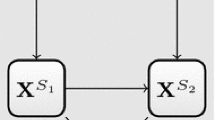Abstract
In predictive modelling, highly correlated predictors lead to unstable models that are often difficult to interpret. The selection of features, or the use of latent components that reduce the complexity among correlated observed variables, are common strategies. Our objective with the new procedure that we advocate here is to achieve both purposes: to highlight the group structure among the variables and to identify the most relevant groups of variables for prediction. The proposed procedure is an iterative adaptation of a method developed for the clustering of variables around latent variables (CLV). Modification of the standard CLV algorithm leads to a supervised procedure, in the sense that the variable to be predicted plays an active role in the clustering. The latent variables associated with the groups of variables, selected for their “proximity” to the variable to be predicted and their “internal homogeneity”, are progressively added in a predictive model. The features of the methodology are illustrated based on a simulation study and a real-world application.





Similar content being viewed by others
References
Barnes RJ, Dhanoa MS, Lister SJ (1989) Standard normal variate transformation and de-trending of near-infrared diffuse reflectance spectra. Appl Spectrosc 45:772–777
Chun H, Keles S (2010) Sparse partial least squares regression for simultaneous dimension reduction and variable selection. J R Stat Soc B 72(1):3–25
Filzmoser P, Liebmann B, Varmuza K (2009) Repeated double cross validation. J Chemom 23:160–171
Hastie T, Tibshirani R, Botstein D, Brown P (2001) Supervised harvesting of expression trees. Genom Biol 2(1):1–12
Jolliffe IT, Trendafilov NT, Uddin M (2003) A modified principal component technique based on the lasso. J Comput Graph Stat 12:531–547
Le Cao KA, Rossouw D, Robert-Grani C, Besse P (2008) Sparse PLS: variable selection when integrating omics data. Stat Appl Genet Mol Biol 7(1): Art No 35
Le Thi HA, Le HM, Nguyen VV, Dinh TP (2008) A DC programming approach for feature selection in support vector machines learning. Adv Data Anal Classif 2:259–278
Leardi R, Boggia R, Terrile M (1992) Genetic algorithms as a strategy for feature selection. J Chemom 6(5):267–281
Naes T, Kowalski B (1989) Predicting sensory profiles from external instrumental measurements. Food Qual Prefer 1:135–147
Park MY, Hastie T, Tibshirani R (2007) Averaged gene expressions for regression. Biostatistics 8(2):212–227
Subedi S, Punzo A, Ingrassia S, McNicholas PD (2013) Clustering and classification via cluster-weighted factor analysers. Adv Data Anal Classif 7(1):5–40
Tibshirani R (1996) Regression shrinkage and selection via the lasso. J Roy Stat Soc B 58(1):267–288
Vichi M, Saporta G (2009) Clustering and disjoint principal component analysis. Comput Stat Data Anal 53:3194–3208
Vigneau E, Qannari E (2003) Clustering of variables around latent components. Commun Stat Simul Comput 32(4):1131–1150
Vigneau E, Thomas F (2012) Model calibration and feature selection for orange juice authentication by 1H NMR spectroscopy. Chemom Intell Lab 117:22–30
Vigneau E, Sahmer K, Qannari EM, Bertrand D (2005) Clustering of variables to analyze spectral data. J Chemom 19(3):122–128
Vigneau E, Endrizzi I, Qannari E (2011) Finding and explaining clusters of consumers using the CLV approach. Food Qual Pref 22(4):705–713
Zou H, Hastie T (2005) Regularization and variable selection via the elastic net. J Roy Stat Soc B 67(3):301–320
Zou H, Hastie T, Tibshirani R (2006) Sparse principal component analysis. J Comput Graph Stat 15:265–286
Author information
Authors and Affiliations
Corresponding author
Rights and permissions
About this article
Cite this article
Chen, M., Vigneau, E. Supervised clustering of variables. Adv Data Anal Classif 10, 85–101 (2016). https://doi.org/10.1007/s11634-014-0191-5
Received:
Revised:
Accepted:
Published:
Issue Date:
DOI: https://doi.org/10.1007/s11634-014-0191-5
Keywords
- Prediction
- Clustering of variables around latent variables (CLV)
- Forward regression model
- Sparse PLS regression




